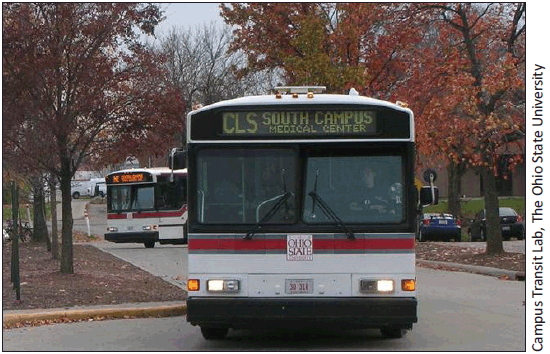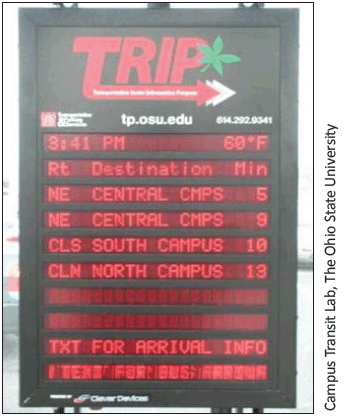You are here
Campus Transit Laboratory: Infrastructure for Research, Education, and Outreach
The Campus Transit Lab (CTL) at The Ohio State University (OSU) is a "living lab" for transit-related research investigations, educational activities, and outreach. Researchers leverage the CTL's unique infrastructure and data collection technologies for discovery and learning that advance transit far beyond campus routes. This project was conducted by OSU in its role as a consortium partner of Purdue University's NEXTRANS University Transportation Center.
Infrastructure
The CTL's unique operating environment is centered on the Campus Area Bus Service (CABS), the extensive bus transit system owned and operated by OSU. CTL is a living lab, where researchers and students directly engage in the field rather than the traditional confined and controlled lab environment. OSU's campus is an ideal setting for this living lab.
OSU is one of the largest single-site campuses in the United States, encompassing more than 3,400 acres, attracting large numbers of visitors, enrolling more than 55,000 students, and employing more than 8,000 faculty and staff. CABS operates a fleet of 30 buses that serves 7 routes comprising 30 route miles and carries approximately 5 million passengers annually.
The transit network serves diverse land uses and facilities: park-and-ride facilities, pedestrian-heavy central campus areas, off-campus residential neighborhoods, commercial areas, and expansive medical facilities. As such, this campus functions like a small city, and CABS provides transit service similar to that provided in many urban areas around the country.
This unique infrastructure is an essential part of the CTL that allows research findings to inform and be transferred to larger city transit systems. Furthermore, it facilitates a collaborative environment involving researchers, students, instructors, technology providers, bus system operators, and passengers.
Technology
Researchers use data collected from CABS's technology-equipped bus fleet to enhance understanding of complex transit-related phenomena and develop means to improve transportation policy, planning, and service. Data-collection technologies and techniques provide researchers with information on bus movements and how riders interact with and experience bus transit services.
CABS buses are equipped with state-of-the-art data-collection, information, and communication technologies, including an Automatic Passenger Count (APC) system, an Automatic Vehicle Location (AVL) system, an inertial navigation system, a bus stop and destination variable message sign enunciation system, and a wireless communications system.
The APC technology delivers accurate passenger boarding and alighting count data, reducing the need for time-consuming onboard data collection if used appropriately. The AVL technology utilizes GPS technology to accurately track vehicles' locations in real time, enabling improved service design and operations. APC and high resolution AVL data are downloaded from buses on a daily basis and automatically transmitted to CTL's server.
In addition to data collected by these automated systems, CTL also relies on onboard origin-to-destination (OD) passenger surveys conducted by students and web-based surveys to collect data necessary to validate the effectiveness of newly developed methods and understand travelers' preferences, attitudes, and choices. All these data are what fuel researchers' discoveries.
Research
Currently, transportation researchers are investigating various questions pertinent to public transportation planning, service design, and operations. One important area of the CTL's research is understanding OD flow patterns—knowing where people start and end their trips on transit routes. The CTL's datadriven research has led CABS planners and service designers to determine that certain OD pairs could be better served if some routes are redesigned or if a new route is introduced to the bus transit network. Methods CTL researchers develop to estimate OD flow movements are a major part of their activities as transportation academics and engineers.
Traveler behavior is another CTL research area. The CTL team has used web-based surveys to study the effects of providing realtime bus arrival information to passengers. This information can be useful to transit passengers for many reasons. Passengers' anxiety about waiting for the next bus may be reduced by knowing when it is expected to arrive and, as a result, use their waiting time more productively. They can also select which route they would want to take or select an alternative mode of transportation.
Whatever the prospective passengers' choices are, providing real-time information reduces the uncertainty inherent to transit systems. In general, reducing waiting time and its uncertainty is expected to improve passenger satisfaction and ultimately increase bus ridership.
Impacts
CTL attracts the interest of industry, namely technology providers focusing on the automatic sensing of transit passenger and vehicle flows and related products and services of interest to public sector planners and operators. In addition, planning organizations, like state, metropolitan, and municipal transportation agencies, can use CTL findings to support their own policy- and decision-making.
The research team is using APC and AVL data provided by the Central Ohio Transit Authority and Los Angeles County Metropolitan Transportation Authority to demonstrate the applicability of their developed methods to larger systems and provide valuable insights. Results are expected to lead to meaningful service improvements to passengers.
This collaborative effort has also proven valuable to CABS and CTL. For example, when CABS staff asked CTL researchers for assistance in scheduling bus routes on campus, stop-to-stop travel times derived from AVL data were used to piece together a schedule for the routes, taking into account the variability in travel times. Schedules were determined to minimize passengers' waiting times while recognizing operational costs and needs. Interactions among routes were considered and efficient schedules produced under several scenarios.
Results such as these prove instrumental for CABS in making final service provision decisions. The exposure to practical issues the researchers attained lead to valuable practice-based grounding necessary for formulating research questions and developing new methods sensitive to the needs of the practicing transit community.
About This Project
Campus Transit Laboratory: Infrastructure for Research, Education, and Outreach is led by principal investigators Mark McCord and Rabi Mishalani of The Ohio State University and is partially funded by the NEXTRANS Center consortium of the U.S. DOT's UTC Program. The NEXTRANS Center is administered by Discovery Park at Purdue University. To learn more about CTL visit http://transitlab.osu.edu/campus-transit-lab. To learn more about NEXTRANS visit www.purdue.edu/discoverypark/nextrans. The NEXTRANS Center's Communications Specialist can be reached at nextrans@purdue.edu.

CABS buses in operation.

Variable message signs at stops are one of several ways TRIP conveys predicted bus arrival times to passengers.
